

Education World: Dr. Ken Shore: Classroom Management for "Specials" [content block] Regular classroom teachers aren't the only educators who confront behavioral problems.

Teachers of special subjects, such as art, music, and physical education also face the challenge of dealing with disciplinary issues. In fact, students might see those classes as an opportunity to have a good time, and be more apt to misbehave. It is not surprising, therefore, that children who act like angels in their regular classrooms can become hellions when they go to "specials. " "Specials" have less instructional time with students than do regular classroom teachers. Establish the tone at the start of class. Set and post your classroom rules. Remind problem-prone students of your rules as they enter class. An Introduction to Classroom Management in Special Education. Classroom management and discipline are very important parts of teaching.
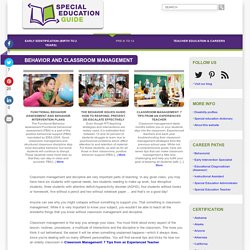
In any given class, you may have have six students with special needs, two students needing to make up work, four disruptive students, three students with attention deficit-hyperactivity disorder (ADHD), four students without books or homework, five without a pencil and two without notebook paper … and that’s on a good day! Anyone can see why you might collapse without something to support you. That something is classroom management. While it is very important to know your subject, you wouldn’t be able to teach all the wonderful things that you know without classroom management and discipline.
Classroom management is the way you arrange your class. When students with special needs are in your class, you must take extra care to plan because their ability to process and their self-esteem are influenced by how well you’ve arranged your class. Lastly, your attitude is crucial. How to Manage Disruptive Behavior in Inclusive Classrooms. Page 1 of 2 by Vera I.
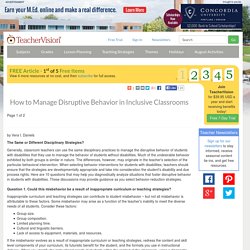
Daniels The Same or Different Disciplinary Strategies? How to Use Positive Reinforcement to Address Child Behavior. Positive reinforcement is a behavior modification technique that is used to encourage good behavior.
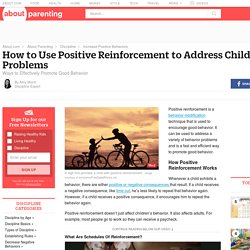
It can be used to address a variety of behavior problems and is a fast and efficient way to promote good behavior. How Positive Reinforcement Works Whenever a child exhibits a behavior, there are either positive or negative consequences that result. If a child receives a negative consequence, like time out, he’s less likely to repeat that behavior again. However, if a child receives a positive consequence, it encourages him to repeat the behavior again. Positive reinforcement doesn’t just affect children’s behavior.
Continue reading below our video Loaded: 0% Progress: 0% Positive%20and%20Not%20So%20Positive%20Discipline%20Techniques.pdf. 6.pdf. Classroom Rules, Classroom management and Behavior Charts. Feelings Chart. Free Printable Feelings Charts Printable List of Feelings This feelings list can be printed and used by kids (and adults) to describe their feelings.

You can use this list of feelings on its own or together with a feelings chart / emotion chart from the selection below. Emotion Chart from A to Z This emotion chart includes a list of feelings from a to z with feeling faces for each emotion. Daily Feeling Chart. Feeling Charts, Feelings Chart, Free Behavior Charts. Educational Resources for Special Needs. Feelingchart. CSEFEL: Center on the Social and Emotional Foundations for Early Learning.
Basic Tips Child Care Providers Can Use to Guide Children's Behavior. Children need adults to teach, guide, and support them as they grow and learn.
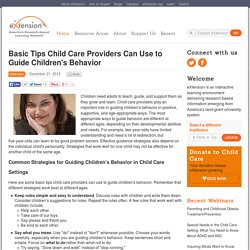
Child care providers play an important role in guiding children's behavior in positive, supportive, and age-appropriate ways. The most appropriate ways to guide behavior are different at different ages, depending on their developmental abilities and needs. For example, two-year-olds have limited understanding and need a lot of redirection, but five-year-olds can learn to be good problem solvers.
Effective guidance strategies also depend on the individual child's personality. Strategies that work well for one child may not be effective for another child of the same age. Coping skills (resilience) Stress; resilience; self esteem; change; comforters; ritual; self control; family break-up; support; problems; routine; resiliency; confident; confidence. ; Resilience is a person's ability to cope with living in spite of stresses.
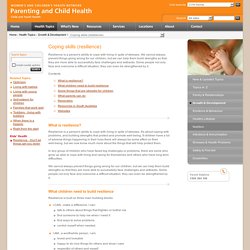
We cannot always prevent things going wrong for our children, but we can help them build strengths so that they are more able to successfully face challenges and setbacks. Some people not only face and overcome a difficult situation; they can even be strengthened by it. Contents Resilience is a person's ability to cope with living in spite of stresses. In any group of children who have faced big challenges or problems, there are some who grow up able to cope with living and caring for themselves and others who have long term difficulties. We cannot always prevent things going wrong for our children, but we can help them build strengths so that they are more able to successfully face challenges and setbacks. Resilience is built on three main building blocks: Cccf-winter07-english.pdf. ResilienceChildrenBooklet.pdf. FLIP IT, Brought to you by Devereux Center for Resilient Children.
Presentation-flip-it. Conscious Discipline - Conscious Discipline.